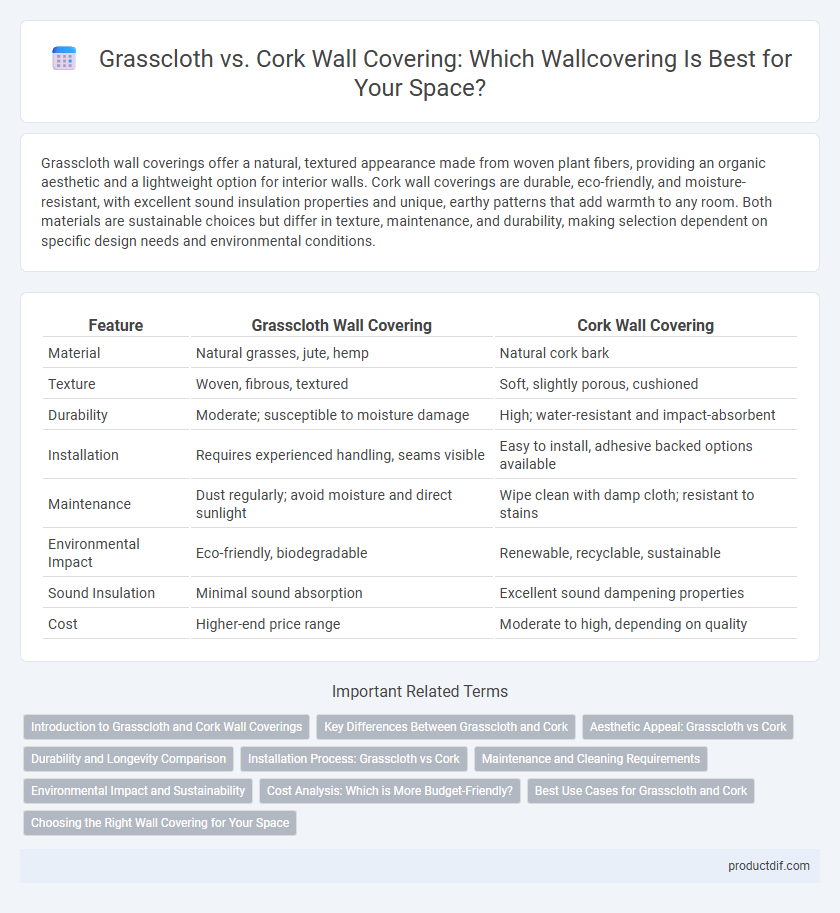Grasscloth wall coverings offer a natural, textured appearance made from woven plant fibers, providing an organic aesthetic and a lightweight option for interior walls. Cork wall coverings are durable, eco-friendly, and moisture-resistant, with excellent sound insulation properties and unique, earthy patterns that add warmth to any room. Both materials are sustainable choices but differ in texture, maintenance, and durability, making selection dependent on specific design needs and environmental conditions.
Table of Comparison
| Feature | Grasscloth Wall Covering | Cork Wall Covering |
|---|---|---|
| Material | Natural grasses, jute, hemp | Natural cork bark |
| Texture | Woven, fibrous, textured | Soft, slightly porous, cushioned |
| Durability | Moderate; susceptible to moisture damage | High; water-resistant and impact-absorbent |
| Installation | Requires experienced handling, seams visible | Easy to install, adhesive backed options available |
| Maintenance | Dust regularly; avoid moisture and direct sunlight | Wipe clean with damp cloth; resistant to stains |
| Environmental Impact | Eco-friendly, biodegradable | Renewable, recyclable, sustainable |
| Sound Insulation | Minimal sound absorption | Excellent sound dampening properties |
| Cost | Higher-end price range | Moderate to high, depending on quality |
Introduction to Grasscloth and Cork Wall Coverings
Grasscloth wall coverings are crafted from natural fibers such as hemp, jute, or seagrass, offering a textured, eco-friendly surface that enhances interior aesthetics with its organic, woven appearance. Cork wall coverings provide durable, renewable insulation and soundproofing benefits, made from the bark of cork oak trees, and contribute to sustainable, soft-to-the-touch wall finishes. Both materials contribute unique tactile qualities and environmental advantages, making them popular choices in eco-conscious interior design.
Key Differences Between Grasscloth and Cork
Grasscloth wall coverings are made from natural fibers like hemp, jute, and arrowroot, offering a textured, organic aesthetic that is lightweight and breathable but not moisture-resistant. Cork wall coverings come from the bark of cork oak trees, providing superior insulation, durability, and moisture resistance, making them ideal for high-traffic or humid environments. While grasscloth emphasizes natural texture and eco-friendly appeal, cork focuses on functionality with sound absorption and resilience.
Aesthetic Appeal: Grasscloth vs Cork
Grasscloth wall coverings offer a natural, textured aesthetic with subtle variations in color and pattern, creating a sophisticated, organic ambiance. Cork wall coverings provide a warm, earthy visual with a distinctive granular texture that enhances cozy, eco-friendly interiors. Both materials contribute unique visual interest, with grasscloth emphasizing elegance and cork highlighting rustic charm.
Durability and Longevity Comparison
Grasscloth wall coverings offer a natural, textured aesthetic but tend to be less durable due to their delicate fibers, making them susceptible to damage from moisture and abrasion. Cork wall coverings provide superior durability and longevity, as their dense, resilient material withstands wear and resists moisture, mold, and mildew better than grasscloth. For high-traffic or humid areas, cork wall coverings deliver a longer-lasting, low-maintenance option compared to the more fragile grasscloth.
Installation Process: Grasscloth vs Cork
Grasscloth wall covering requires skilled installation due to its delicate, natural fibers that easily absorb moisture and show adhesiveness inconsistencies, necessitating meticulous seam alignment and careful handling. Cork wall covering, by contrast, offers a straightforward installation process with peel-and-stick options or adhesive application, providing a more forgiving material that resists tearing and can be cut easily on-site. Both materials demand surface preparation, but cork's durability and flexibility often make it a preferred choice for quicker, less labor-intensive installations.
Maintenance and Cleaning Requirements
Grasscloth wall covering requires gentle maintenance due to its natural fibers, needing vacuuming with a soft brush attachment and spot cleaning with a dry or slightly damp cloth to prevent damage. Cork wall covering is more durable and moisture-resistant, allowing for easier cleaning with mild soap and water while resisting mold and mildew growth. Both materials benefit from avoiding harsh chemicals and excessive moisture to preserve their texture and appearance.
Environmental Impact and Sustainability
Grasscloth wall coverings are made from natural fibers like jute, hemp, and other grasses, making them biodegradable and renewable with minimal environmental impact during production. Cork wall coverings derive from the bark of cork oak trees, which are harvested sustainably without harming the tree, promoting carbon sequestration and forest preservation. Both materials offer eco-friendly options, but cork's durability and regenerative harvesting process make it particularly favorable for long-term sustainability.
Cost Analysis: Which is More Budget-Friendly?
Grasscloth wall coverings typically cost between $5 to $15 per square foot, making them a moderately priced option for textured, natural fiber walls. Cork wall coverings range from $7 to $20 per square foot but offer enhanced durability and insulation properties, which can reduce long-term expenses. When considering installation and maintenance, grasscloth often requires more delicate handling and professional installation, potentially increasing overall costs compared to the easier-to-install and low-maintenance cork panels.
Best Use Cases for Grasscloth and Cork
Grasscloth wall covering excels in living rooms and bedrooms where aesthetic appeal and texture enhance interior design, providing a natural, woven look that adds warmth and depth. Cork wall covering is ideal for offices, playrooms, or areas requiring sound insulation and durability, offering natural resistance to moisture and impact while serving as a sustainable, eco-friendly option. Both materials support eco-conscious choices but differ in performance, with grasscloth prioritizing visual texture and cork emphasizing functionality and resilience.
Choosing the Right Wall Covering for Your Space
Grasscloth offers a natural, textured appearance made from woven plant fibers, ideal for adding warmth and sophistication to living rooms or bedrooms. Cork wall covering provides excellent sound insulation and durability, making it a practical choice for offices or high-traffic areas. Consider environmental factors, maintenance needs, and aesthetic preferences to select the perfect wall covering that balances style and functionality for your space.
Grasscloth vs Cork wall covering Infographic

 productdif.com
productdif.com